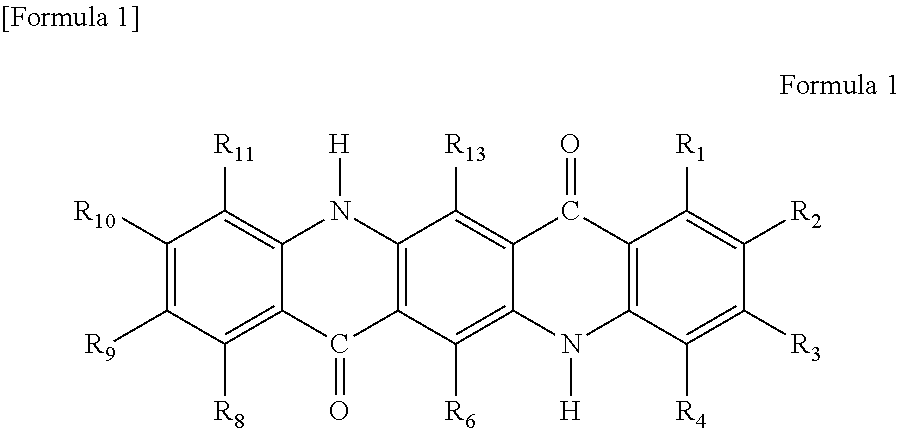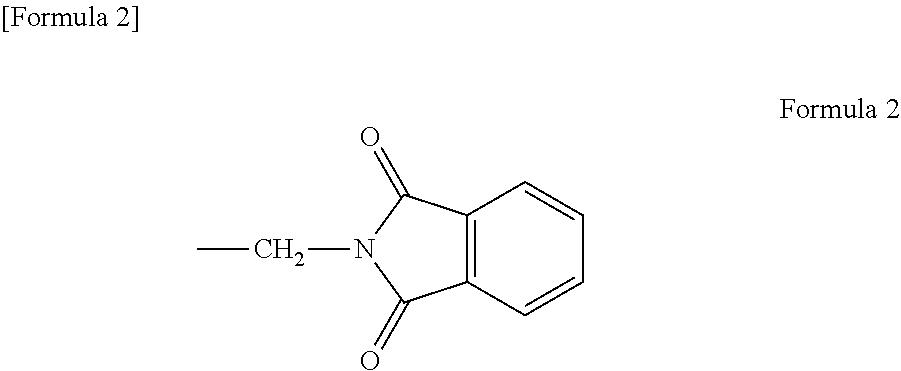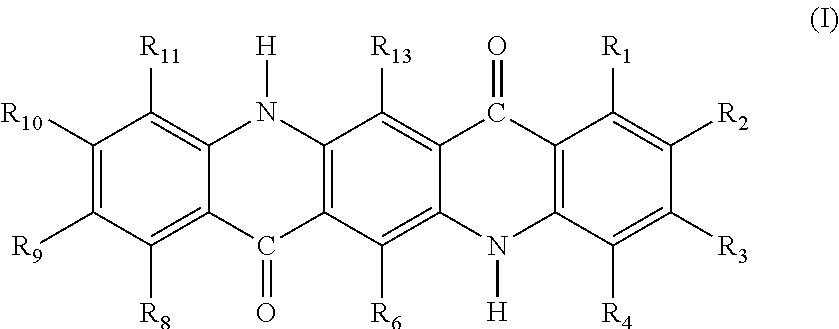Method for producing halogenated organic pigment, halogenated organic pigment obtained by the production method, and colored composition comprising the same
a technology of organic pigments and halogenated organic pigments, applied in the direction of printing, anthracene dyes, inks, etc., can solve the problems of narrow color tone adjustment range, difficult preparation of fine particles, and attention-grabbing problems affecting their production, and achieve high total yield, high safety and easy handling
- Summary
- Abstract
- Description
- Claims
- Application Information
AI Technical Summary
Benefits of technology
Problems solved by technology
Method used
Image
Examples
example 1
[0131]99 parts of 98% sulfuric acid were mixed with 21 parts of 30% fuming sulfuric acid to prepare 120 parts of 99.5% sulfuric acid. To this sulfuric acid, 0.1 part of iodine was added as a catalyst, and thereafter, 20 parts of copper phthalocyanine (C. I. Pigment Blue 15, T-99 CRUDE BLUE, manufactured by ZHUHAI TOYOCHEM CO., LTD.) was added as a phthalocyanine pigment while keeping the temperature at 30° C. or lower and cooling in an ice bath. Subsequently, the temperature was increased to 50° C., 2.7 parts of trichloroisocyanuric acid was then added to the reaction mixture, and the obtained mixture was stirred at the same temperature as described above for 3 hours. At this time, the amount of trichloroisocyanuric acid was 0.33 times the mole of copper phthalocyanine, and was 1.00 molar equivalent based on available chlorine atoms. Subsequently, the above-described reaction solution was poured into 600 parts of water while stirring, and the obtained solution was then heated to 70°...
examples 2 to 10
[0135]Each halogenated phthalocyanine was obtained in the same method as in Example 1 with the exception that the conditions were changed to those shown in Table 1 and Table 2. 2% Fuming sulfuric acid was prepared by mixing 86 parts of 98% sulfuric acid with 34 parts of 30% fuming sulfuric acid. The molar equivalent of the amount charged shown in Table 1 indicates the molar equivalent based on available halogen atoms. The number of chlorine substitutions, the number of bromine substitutions, and the yield of the obtained halogenated phthalocyanines are also shown in Table 2.
[0136]The used N-haloimide compounds were all granular, white solids, and were easily-handled, and no gas was generated during the reaction, and a series of operations were extremely easily carried out.
[0137]The chlorinated copper phthalocyanines obtained in Examples 2 to 10 were observed under an electron microscope. The average particle diameter of all of these compounds was 0.06 μm. Aluminum phthalocyanine and...
example 11
[0147]10 parts of C. I. Pigment Yellow 147 (Filestar Yellow RNB, manufactured by BASF) which is an anthraquinone pigment was added to and was dissolved in 150 parts of chlorosulfonic acid, and thereafter, 2.6 parts of trichloroisocyanuric acid were added to the solution. The obtained mixture was stirred at 20° C. for 2 hours. At this time, the amount of trichloroisocyanuric acid was 0.66 times the mole of Pigment Yellow 147, and was 2.0 molar equivalents based on available chlorine atoms. Subsequently, the reaction solution was poured into 600 parts of water while being stirred. The obtained solution was heated to 70° C., and was then subjected to filtration, washing with hot water, washing with 1% sodium hydroxide aqueous solution, and washing with hot water in this order. Thereafter, the resultant was dried to obtain 10.8 parts of chlorinated Pigment Yellow 147 having an average number of chlorine substitutions of 1.9. The yield was 97%.
PUM
| Property | Measurement | Unit |
|---|---|---|
| temperature | aaaaa | aaaaa |
| temperature | aaaaa | aaaaa |
| molar ratio | aaaaa | aaaaa |
Abstract
Description
Claims
Application Information
 Login to View More
Login to View More - R&D
- Intellectual Property
- Life Sciences
- Materials
- Tech Scout
- Unparalleled Data Quality
- Higher Quality Content
- 60% Fewer Hallucinations
Browse by: Latest US Patents, China's latest patents, Technical Efficacy Thesaurus, Application Domain, Technology Topic, Popular Technical Reports.
© 2025 PatSnap. All rights reserved.Legal|Privacy policy|Modern Slavery Act Transparency Statement|Sitemap|About US| Contact US: help@patsnap.com



